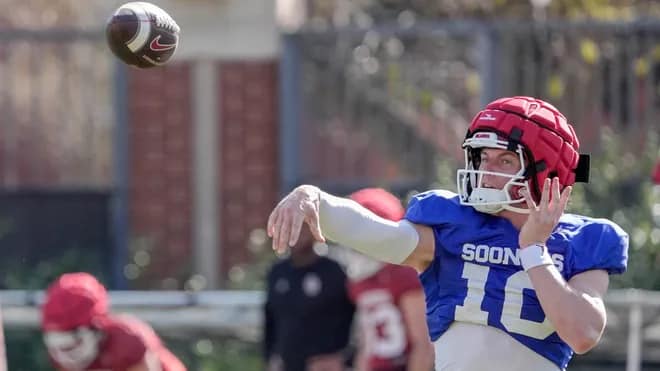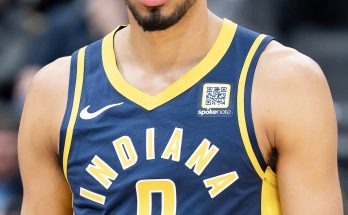The college football offseason has entered a new era—one where roster building through the transfer portal is just as important as high school recruiting. With players making career-altering decisions and programs reshaping their identities overnight, ESPN’s final ranking of the top 100 players in the transfer portal offers a definitive look at the most impactful athletes set to change the trajectory of the 2025 season. Among the names scattered throughout the list are former backups poised for breakout roles, stars who shocked their fanbases by leaving, and defenders hungry for the spotlight they felt they never got at their previous stops.
Sitting atop ESPN’s prestigious list is quarterback John Mateer, a name that now commands respect throughout the college football world. Once a relative unknown tucked behind a more heralded signal-caller, Mateer’s emergence has been nothing short of remarkable. After flashing brilliance in limited action last season, his decision to hit the portal was met with both curiosity and intrigue. Programs saw not just a player with talent, but one with a fire that couldn’t be ignored. Mateer’s combination of mobility, poise, and accuracy made him the most coveted quarterback on the market, and by the time he committed to his new school, the arms race was over. Coaches believe he can elevate any offense, and ESPN clearly agrees—slotting him as the No. 1 overall portal player speaks volumes about how highly he is regarded.
Mateer’s skill set aligns perfectly with the modern offensive demands in college football. His ability to extend plays outside the pocket and his innate understanding of defensive leverage makes him a nightmare to scheme against. What truly separates Mateer, though, is his football IQ. Scouts rave about his ability to read complex coverages, adjust protections, and identify weak spots pre-snap. In a year where multiple quarterbacks with high-level experience also entered the portal, it’s Mateer who stood tallest. Not because of a statistical onslaught, but because of what he represents—a coachable, dynamic leader ready to command a team and push for a conference title. Whispers of potential Heisman dark horse candidacy are already circling. For a player who started last season as an understudy, that’s a testament to the power of preparation and the platform the portal now provides.
Further down the list at No. 19 is running back Jaydn Ott, a player who could easily be a top-10 pick based on raw production alone. Ott’s ranking isn’t a slight; rather, it’s a reflection of the saturated depth at the top of this year’s class. Still, few backs in college football are as complete as Ott. Explosive in space, punishing between the tackles, and versatile enough to line up as a slot receiver, Ott gives his new team a three-down weapon who will instantly become the focal point of the offense. His departure sent shockwaves through his former program, where he had become a cornerstone on and off the field. But the move was strategic—Ott wanted to compete for championships, and now he finds himself on a roster primed for a deep postseason run.
Ott’s vision is perhaps his most underrated trait. He doesn’t just run to where the play is designed—he anticipates flow, manipulates linebackers with subtle cuts, and has an uncanny knack for creating something out of nothing. Coaches describe his balance through contact as “NFL-ready,” and his blocking ability makes him an every-down asset. In a portal filled with speedsters and bruisers, Ott is the rare hybrid who does it all. His new offensive coordinator reportedly plans to feature him heavily, both in the running game and through creative packages in the passing attack. That versatility should not only boost his draft stock but make his new team exponentially more dangerous on offense.
At No. 99 on the list, defensive back Kendal Daniels rounds out ESPN’s top 100—but don’t let the number fool you. Daniels is a player whose potential impact may far outweigh his ranking. A former four-star recruit, Daniels has always had the physical tools—length, speed, and physicality—but what he needed was a system that allowed him to play free and fast. After transferring, he now finds himself in a defensive scheme tailor-made for his aggressive style. Coaches believe Daniels can thrive as a hybrid safety-linebacker, using his size to defend the run and his range to patrol the deep middle.
Daniels’ biggest strength lies in his versatility. He can play single-high safety, roll down into the box, and even match up against tight ends in man coverage. That kind of positional flexibility is becoming more valuable as offenses evolve. What stood out to ESPN’s evaluators was his ability to flip the momentum of a game with one play—be it a jarring hit, a timely pick, or a key third-down stop. His instincts have sharpened, and with a fresh start, Daniels could be in for the breakout season that eluded him previously. A strong campaign could see him climb up draft boards rapidly, especially with scouts already intrigued by his frame and ceiling.
The rankings reflect not just past performance, but projected value. ESPN’s methodology factored in not only stats and film but also team fit, positional scarcity, and leadership qualities. That’s why a quarterback like Mateer could edge out others with more playing experience—his projected upside in his new environment is simply too high to ignore. Similarly, Ott’s fit in a title-contending offense makes him a weapon of war rather than a luxury. And Daniels, despite his modest ranking, lands on a team where his skill set is maximized, giving him a platform to make noise in a national spotlight.
What the final rankings show, more than anything, is how the transfer portal has become the ultimate equalizer in college football. Programs no longer have to wait three years for talent to develop. They can reload instantly with players like Mateer, Ott, and Daniels—who aren’t just placeholders, but program-changers. The portal has turned roster construction into a chess match, with coaches acting as both recruiters and roster architects. Talent is spread more evenly, and parity across conferences is increasing. This year’s top 100 includes players from Power Five giants, Group of Five standouts, and even FCS risers—all looking to prove they belong on the biggest stage.



